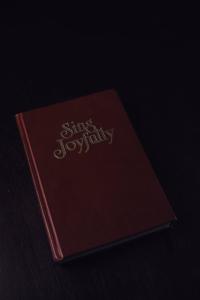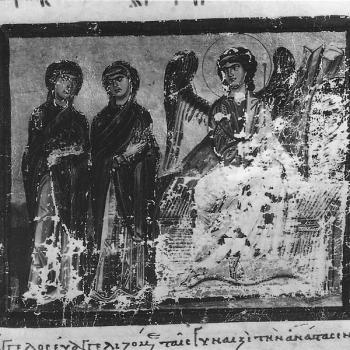If you follow me on Facebook, you’ll note I occasionally ask everyone about their favorite hymns. As much as I love the modern Christian worship scene (and many others do, as well), there’s something special and timeless about our favorite hymns. The long-held tradition of congregational singing inspires a sense of spiritual unity; connection both to God and one another. Far from being boring or tired, the exploration of hymns tells the story of faith. Whether written in times of great trial or praise, hymns reveal a timeless sense of eternal perseverance as we sojourn through this world. Here I present the story behind ten favorite hymns (including my own).

1. Come, Thou Fount of Every Blessing
(Robert Robinson, 1758)
Come, Thou Fount of Every Blessing is often classified as an Advent or Christmas hymn. In reality, it is the autobiographical story of the composer. Penned by Robert Robinson when he was 22, its contents herald thoughts of divine grace. More specifically, it depicts his experience with divine grace. Moved by a powerful conversion under the preaching of George Whitefield, Robert Robinson would go on to serve as a pastor in both the Methodist and Baptist churches. Known as an unusual man, he rose to prominence as both a preacher and scholar within the church of his day.
With an abiding theology that transcends denomination, Come, Thou Fount of Every Blessing was the first hymn selected for an Anglican Hymnal used at the Church of Christ in Whitechapel.
Jesus sought me when a stranger,
wandering from the fold of God;
He, to rescue me from danger,
interposed His precious blood.
2. Be Thou My Vision
(Dallán Forgaill, 6th Century)
Would it surprise you to learn the hymn, Be Thou My Vision, dates from between 400-800 AD? Attributed to Dallán Forgaill (an early Irish saint), this timeless hymn depicts spiritual life in ancient Ireland. The hymn is what’s known as a lorica, a prayer recited for protection. The militant imagery (depicted by swords, shields, towers, and the like) references clan life in Ireland, noted by frequent battles. To the early Irish, God as the High King of Heaven declared Him protector and defender of clan life, especially in its uncertainty.
It was translated and set to the most familiar meter (an old Irish tune) in 1912 by Eleanor Hull, an Old Irish scholar.
Be Thou my battle Shield, Sword for the fight;
Be Thou my Dignity, Thou my Delight;
Thou my soul’s Shelter, Thou my high Tow’r:
Raise Thou me heav’nward, O Pow’r of my pow’r.
3. It is Well With My Soul (When Peace Like a River)
(Horatio Spafford, 1873)
A hymn inspired by tragedy, It is Well With My Soul was written in direct response to Horatio Spafford‘s personal experiences. A Chicago lawyer with a number of property investments, the Great Chicago Fire of 1871 left him financially strapped. He experienced further financial loss in 1873 during economic downturn. Then, while planning a trip to Britain with his family to assist the ministry of D.L. Moody, he was delayed due to complications from his economic situation. His family went on ahead without him, only for the SS Ville du Havre to sink in transit. His wife survived, while all four of his daughters died. As he crossed the Atlantic alone to meet his grieving wife, he wrote the words to the now famous hymn. The melody, written by Philip Bliss, is titled Ville du Havre after the sinking ship.
When peace like a river, attendeth my way,
When sorrows like sea billows roll;
Whatever my lot, Thou hast taught me to say
It is well, it is well, with my soul.
4. What a Friend We Have in Jesus
(Joseph M. Scriven, 1855)
A poem originally published anonymously, Joseph M. Scriven wrote What a Friend We Have in Jesus for a special person: his mother. Joseph Scriven was an Irish-born preacher living in Canada when he sought to comfort his lonely mother who still lived in Ireland. Set to music in the 1880s, this song has been a sort of comfort and inspiration for generations.
What a Friend We Have in Jesus can be found in a number of different versions and languages, including Swahili, Kimeru, Japanese, Indonesian, Hindi, and Korean.
What a friend we have in Jesus,
all our sins and griefs to bear!
What a privilege to carry
everything to God in prayer!
O what peace we often forfeit,
O what needless pain we bear,
all because we do not carry
everything to God in prayer!
5. Blessed Assurance
(Fanny Crosby, 1873)
A story of girl power, Fanny Crosby composed more than eight thousand hymns and gospel songs – despite being blind from a very young age. During a visit, Fanny’s friend, Phoebe Knapp, played a new melody she’d recently written. Uncertain of the words to go with the tune, Fanny said, “Blessed assurance, Jesus is mine.” The teamwork of these two women became the history of this beloved hymn.
This is my story, this is my song,
Praising my Savior all the day long.
This is my story, this is my song,
Praising my Savior all the day long.
6. Nothing But the Blood of Jesus
(Robert Lowry, 1876)
Some hymns intersect with both inspiration and history. Such is the case with Nothing But the Blood of Jesus. Written by Robert Lowry (a Baptist minister and professor), this hymn speaks on the atonement of Christ as found in Hebrews 9. It gained fame through camp meetings popular in the late 1800s.
O precious is the flow
that makes me white as snow;
no other fount I know;
nothing but the blood of Jesus.
7. How Great Thou Art
(Carl Boberg, 1885)
Carl Boberg was a Swedish poet and preacher who found himself overcome by God’s hand in creation. While out walking, he heard the local church bells ring and was taken with a sudden storm. As quickly as the storm rose, it passed to a perfect peace and calm as he looked out over Monsteras Bay. The majesty of the scene inspired a nine-stanza poem O Store Gud (O Great God), inspired by Psalm 8. The poem was translated and turned into a hymn by Stuart K. Hine in 1949.
8. Great is Thy Faithfulness
(Thomas Chishlom, 1923)
Written in Baldwin City, Kansas in 1923, Methodist minister Thomas Chishlom wanted to celebrate the faithfulness of God throughout his life. The song is based on Lamentations 3:23. William Runyan set the lyrics to music. The song gained popularity as Billy Graham frequently used it in his crusades.
Great is Thy faithfulness, O God my Father;
there is no shadow of turning with Thee;
Thou changest not, Thy compassions, they fail not;
as Thou hast been, Thou forever wilt be.
https://www.youtube.com/watch?v=2eQ1oal44wU
9. Sweet Hour of Prayer
(William W. Walford, 1842)
Prayer is a beautiful aspect of the Christian faith. In Sweet Hour of Prayer, William Walford (an obscure, blind lay preacher in Britain) expounds on the believer’s life of private prayer. In 1842, a friend of William’s stopped by his trinket shop to request written lyrics of a new poem he’d written on prayer. William Bradbury, a loved composer, wrote the melody for this, his favorite hymn, in 1861.
Sweet hour of prayer! sweet hour of prayer!
that calls me from a world of care,
and bids me at my Father’s throne
make all my wants and wishes known.
In seasons of distress and grief,
my soul has often found relief,
and oft escaped the tempter’s snare
by thy return, sweet hour of prayer!
10. Sweet, Sweet Spirit
(Doris Akers, 1962)
Some consider Sweet, Sweet Spirit a gospel song; some a hymn. Whatever it is, it introduced a powerful spiritual sound to the world. Doris Akers was choir director of Sky Pilot Revival Center in Los Angeles, California. By all accounts, the Sky Pilot Church choir was the first integrated choir in Los Angeles, thus a very big deal in the early 1960s. One day in 1962 while preparing the choir for service, Doris felt as if the choir wasn’t spiritually prepared enough through prayer. While encouraging them to press in to prayer that much harder, the song Sweet, Sweet Spirit came to her. She would go on to self-publish the music herself; the copyright later secured by Manna Music.
A copy of the original edition of Sweet, Sweet Spirit can be found at the African-American Sheet Music Collection at the Stuart A. Rose Library of Emory University.
There’s a sweet, sweet Spirit in this place,
And I know that it’s the Spirit of the Lord.
There are sweet expressions on each face,
And I know you feel the presence of the Lord.
What are your favorite hymns?
As can be seen above, hymns have stories. Those stories tell of spiritual influence, perseverance through trial, belief in a better day, and in the power of God in song. What’s your favorite Christian hymn, and why? Sing it out as a joyful song to the Lord this day!














